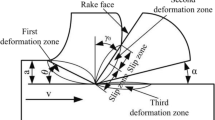Abstract
Ultrasonic machining is a mechanical material removal process used to erode holes and cavities in hard or brittle workpiece by using shaped tools, high-frequency mechanical motion, and an abrasive slurry. In the present study, outcome of the Taguchi model has been used for developing a mathematical model for tool wear rate; using Buckingham’s π-theorem for stationary ultrasonic machining of titanium and its alloys. Six input parameters, namely, tool material, power rating, slurry type, slurry temperature, slurry concentration, and slurry grit size were selected to give output in form of tool wear rate. This study will provide main effects of these variables on tool wear rate and will shed light on the tool wear mechanism in ultrasonic machining of titanium and its alloys. The comparison with experimental results will also serve as further validation of model.
Similar content being viewed by others
References
Rupinder S, Khamba JS (2004) Machining characteristics comparison of titanium alloys in ultrasonic assisted drilling. In: Proceedings of International Conference on recent advances in composite materials, India, pp. 438–443
Rupinder S, Khamba JS (2007) Macro-model for ultrasonic machining of titanium and its alloys(:) designed experiments. J Eng Manuf B2:221–229
Rupinder S, Khamba JS (2003) A framework for modeling the machining characteristics of titanium alloys using USM. In: Proceedings of Int. Conf. Digital aided modeling and simulation, India, pp. 31
Rupinder S, Khamba JS (2003) Silicon carbide slurry effect in ultrasonic assisted drilling of titanium alloy. Journal of Manufacturing Technology Today 2(7):8–11
Khamba JS, Rupinder S (2003) Effect of alumina (white fused) slurry in ultrasonic assisted drilling of titanium alloys (TITAN 15). In: Proceedings of National Conference on Materials and Related Technologies (NCMRT), India, pp. 75–79
Rupinder S, Khamba JS (2004) Study of machining characteristics of titanium alloys in ultrasonic machining. In: Proceedings of the 21st AIMTDR conference, India, pp. 155–160
Rupinder S, Khamba JS (2004) Comparison of machining characteristics of titanium alloys: effect of slurry in ultrasonic machining process. In: Proceedings of global congress on manufacturing and management (GCMM), India, pp. 54–58
Benedict GF (1987) Book on non traditional manufacturing processes. Marcel Dekker, New York, pp 67–86
Thoe TB, Aspinwall DK, Wise MLH (1998) Review on ultrasonic machining. Int J Mach Tools Manuf 38(4):239–255. doi:10.1016/S0890-6955(97)00036-9
Scab KHW (1990) Parametric studies of ultrasonic machining, SME Tech. paper, pp. 11.
Neppiras EA (1972) Macrosonics in industry. Ultrasonics 10:9–13. doi:10.1016/0041-624X(72)90207-7
Perkins J (1972) An outline of power ultrasonics. In: Technical Report by Kerry Ultrasonics, pp. 7
Farago FT (1980) Abrasive methods engineering. Vol. 2, Industrial, pp. 480–481
Balamuth L (1964) Ultrasonic vibrations assist cutting tools. Metalwork Prod 108:75–77
Nishimura G (1954) Ultrasonic machining—part I. J Fac Eng 24(3):65–100
Kennedy DC, Grieve RJ (1975) Ultrasonic machining—a review. The Prod Engineer 54(9):481–486
Kremer D (1991) New developments on ultrasonic machining, SME Technical Paper, MR91-522, pp. 13
Clifton D, Imal Y, McGeough JA (1993) Some ultrasonic effects on machining materials encountered in the offshore industries. In: Proceedings of 30th Int. MATADOR Conf., pp. 119–123
Shaw MC (1956) Ultrasonic grinding. Microtechnic 10(6):257–265
Moreland MA (1991) Ultrasonic machining—Book chapter: ceramics and glasses, ASM International, Engineering Material Handbook, ISBN 0871702827, Schneider and Samuel J., Vol.4, pp. 359–362
Garde RJ, Mirajgaoker AG (1988) Book on engineering fluid mechanics, Chapter-7 on Dimensional analysis and similitude. Chand, Roorkee, India, pp 235–236
Bansal RK (1998) A text book of fluid mechanics and hydraulic machines, Chapter-12, Dimensional and model analysis. Laxmi, New Delhi, pp 595–600
Kumar DS (1987) Fluid mechanics and fluid power engineering, chapter-6, dimensional analysis and model similitude. Kataria, India, pp 323–326
Modi PN, Seth SM (1998) Hydraulics and fluid mechanics, chapter-17, dimensional analysis. Standard, New Delhi, pp 830–833
Streeter VL, Benjamin WE (1983) Book on fluid mechanics, international student edition. McGraw-Hill, Japan, pp 160–169
Buckingham E (1915) Model experiments and the form of empirical equations. Trans. ASME 37:263–296
Amitabha G, Mallik AK (1996) Book on manufacturing science, chapter 6. East–West, India, pp 335–353:409–411
Author information
Authors and Affiliations
Corresponding author
Rights and permissions
About this article
Cite this article
Singh, R., Khamba, J.S. Mathematical modeling of tool wear rate in ultrasonic machining of titanium. Int J Adv Manuf Technol 43, 573–580 (2009). https://doi.org/10.1007/s00170-008-1729-5
Received:
Accepted:
Published:
Issue Date:
DOI: https://doi.org/10.1007/s00170-008-1729-5




